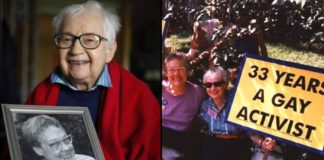
As a college student, I hungered for Arab and Muslim representation. Prejudice against our communities was mainstream and demoralizing. Things, however, can sometimes change sooner than we expect.
Although Muslims and Arabs are still maligned, it is no longer as widespread and is often counterbalanced by allyship and, crucially, Muslim and Arab representation. From Hulu’s “Remy,” Netflix’s “Master of None,” HBO Max’s “Sort Of,” to the upcoming premiere of Disney+’s “Ms. Marvel” to Muslim characters on “Love Victor,” “Never Have I Ever,” and “Genera+ion,” Muslim characters and creators are now common. And these creators are diverse, proud, and often queer.
Mahersalah Ali is a two-time Oscar winner (one for the Black queer Best Picture winner “Moonlight”) and Riz Ahmed is the first Muslim to be nominated for Best Actor; he won an Oscar this year for a short film taking on British xenophobia, and spearheading an initiative to boost Muslim representation in Hollywood from screenwriters to actors.
From starving to satisfied, it has been quite a transformation in American culture. And it’s not only TV and film. Political representation isn’t novel anymore. I still remember when former Rep. Keith Ellison was asked on CNN to prove his loyalty by the conservative host Glenn Beck. Today, Reps. Ilhan Omar and Rashida Tlaib are progressive trailblazers. Irvine, Calif., has a Muslim mayor in Farrah Khan. Joe Biden has nominated the first Muslims to the federal judiciary, one has been confirmed and the other, civil rights lawyer Nusrat Choudhury, awaits Senate confirmation. And Biden, lest we forget, said “inshallah” (God willing) on the presidential debate stage. “We’ve made it,” I want to shout. But I know we’re still fighting for full normalization in American life.
Hence my excitement over three new books (two cookbooks and one art text) that feature Arab and Muslim heritage, art, and gastronomy.
Arab roots of Portuguese cooking
“To these new rulers [the Moors], cuisine was an art, and food a gift from God that should be consumed in moderation and shared with those in need,” writes Leandro Carreira, the author of “Portugal: The Cookbook.” It’s not surprising to learn that Arabs and Berbers shaped the evolution of Portuguese cuisine, but what’s striking is the nature of its legacy. In this cookbook of 700 recipes, half draw from the Moors.
When Moors conquered the Iberian Peninsula (Portugal and Spain) they brought with them not only warriors and administrators but architects, astronomers, poets, and, inter alia, cooks along with cookbooks, such as the Medieval “Kitab al Tabikh.”
The Moors introduced hydraulics that irrigated the farmland (along with orchards and leafy gardens) and beautified the land by planting citrus trees both for the fruit and scent. The list of crops introduced by Moors includes eggplant, artichoke, carrot, lentils, cucumber, and lettuce. The latter would later christen the residents of Lisbon, who are colloquially known as Alfachinhas (“little lettuces”). Moors popularized sour oranges, apricots, dates, melons, and watermelons; spices such as pepper and ginger; pickling of olives and nuts; sour marinade to preserve fish; rose water and orange blossom. The Moors’ vinegary salads were the precursor to gazpacho. The introduction of sugarcane later severed Portuguese colonization and fueled the slave trade, and transformed sugar from luxury to staple.
Naturally, the North African rulers brought couscous, the main consumed wheat until the late 16th century. To this day, northwestern Portuguese villagers prepare couscous using the methods and utensils introduced by Berbers 900 years ago.
The Moors cultivated hospitality and conviviality at the table along with the order in which food is served: soups followed by fish or meat and concluding with sweets. The Arabs’ cousins, the Jews played their part in shaping Portuguese cooking, too. Jews prepared their post-Sabbath meal by laying aside a slow-burning stew of meat, chickpeas, collard greens, hard-boiled eggs, and vegetables; today, the Portuguese call it Adafina. Jews introduced deep-fried vegetables and Portuguese missionaries later brought them to Japan and (voilà!) tempura.
In its history, “Portugal” evokes our interwoven humanity.
Arabiyya: Cooking as an Arab in America
The past few years have seen cookbooks with narratives of culture and personal journeys foregrounding recipes — many focused on Arab culture. “The Gaza Kitchen” by Laila el-Haddad and Maggie Schmitt and “The Palestinian Table” and “The Arabesque Table” by Reem Kassis, for example. To this list, we can add “Arabiyya: Recipes from the Life of an Arab in Diaspora” by the James Beard finalist Reem Assil.
For connoisseurs of Arab food in America, Reem is no stranger. Reem’s California, a bakery in Oakland and San Francisco, has acquired temple status for its use of California’s ingredients in the service of Arab dishes. A few years ago, the New York Times praised Reem’s as an “Arab Bakery in Oakland Full of California Love.” (The bakery was, sadly, the target of vulgar anti-Palestinian prejudice for its mural of Palestinian activist Rasmeah Odeh.)
Food was Reem’s saving grace. Facing a debilitating digestive disorder, and the wreck of familial stress, Reem left college and headed to the Bay Area live with her Arab uncle and Jewish aunt. Soothed by California’s climate, nature, and ingredients, she found mental and physical healing — and roots and purpose.
“Arabiyya” is a guide to California-based, Arab-rooted recipes alongside tales of Reem’s journey and her family’s. Her grandparents fled the Nakba — the 1948 “catastrophe” of the forced exile of roughly 750,000 Palestinians at the hands of Israeli troops — and the Naksa, the 1967 War that forced her family to decamp once more for Lebanon. The Lebanese Civil War led to one more flight to Greece, and finally, California.
Growing up American, Reem knew little of her grandmother’s resilience. After her sitty’s (colloquial Arabic for grandmother) passing, she pasted together tales from relatives of her grandmother’s determination to uphold Arab hospitality no matter where she landed. Her identity as a Palestinian was threatening both in Lebanon and America — but she walked with dignity. Arab hospitality meant that home was a safe comfort no matter the headwinds outside, and, at times, her grandmother went lengths to survive. A tale of sneaking out during a pause in fighting in Beirut became family lore: sitty couldn’t forget her lemons (who would serve fish without lemons?!) even after a rocket attack knocked her down.
Food’s healing and grounding became the thread uniting Reem with sitty. “I’ve come to realize that my grandmother, who loaded the table to its edges with tasty morsels of my favorite foods, lives through me,” Reem relates.
Reem’s journey to cook and bake as love and spontaneity opened a window to heritage — a family’s history and Arab pride. Her recipes (like the California Fattoush Salad where traditional tomatoes are swapped for oranges and citrus and fried sunchokes) overflow with love. “Arabiyya” is destined to be a classic among Arab-Americans.
Arab artists in their prime
Artists from the Arab world exhibiting in the West face a challenge: Our culture is ubiquitous in Western depictions but poorly understood; a dilemma for the artist who must inevitably “interrogate the stereotypes that spectators bring to the practice of looking at mythologized places,” in the words of critic Omar Kholeif in his review of the Abu Dhabi-born and NYC and Dubai-based Farah Al Qasimi.
Al Qasimi is one of five Arab artists featured in the new collection on “art’s next generation” entitled “Prime.” In “After Dinner 2” (2018), Al Qasimi captures the pressures of domestic life in her native UAE and the misconceptions westerners have about Arab domesticity. A mother stands behind her daughter kneeling on the couch while looking out at the window. The mother’s stance is recognizable to any child raised by an Arab mother: head tilted up and her arms stretched out — a plea for God’s mercy in the face of a stubborn child. The pink and white staging of the drapes and couch suggest the mother-daughter dispute is about marriage, the daughter having sights on another admirer. Neither the daughter’s nor the mother’s face is visible. The mother’s face overflows out of frame while the daughter’s rests behind the drapes. Al Qasimi’s photograph turns on its head the Western conception that Arab women are hidden “behind the veil;” their life is plain to see if one discards their preconceived notions and recognizes that mothers and daughters differ universally.
Gulf Arab states, soaked in oil and gas money, however, pander to Western standards. Alia Farid scrutinizes the imitation. Urbanization has upended life in the Gulf, including in the official representation of culture. Seeking to parade heritage, Gulf states are crafting historical narratives that embody less the realization of culture and more a contrived display that weaves together disparate artifacts, as Farid displays in a mock-museum exhibition titled “Vault” (2019). These exhibitions stand as staid advertisements — a defensive declaration: “We, too, have culture!” — placing together all manners of ancient and modern objects without telling a coherent story or inspiring new creativity.
In a juxtaposition, “At the Time of the Ebb” (2019) is a video installation documenting the celebration of Nowruz Sayadeen (Fisherman’s New Year) on the island of Qeshm, Iran. “We are brought close to culture at its grassroots level — the suggestion being that cultural life is built in communities as opposed to something to represent within the entanglements of a global museum industry, one that willfully neglects the culture it seeks to validate,” observe critics Hana Noorali and Lynton Talbot.
The Middle East’s wars and rivalries inform the work of Lebanese artist Rayyane Tabet, who works in Beirut and San Francisco. “Steel Rings” (2013) is a recreation of the Trans-Arabian Pipeline that was abandoned due to political upheaval but not before hundreds of miles of pipes were laid (and remain) underground. In Tabet’s exhibition, steel rings laid on the floor stand in for the pipeline’s route with engravings on the rings marking the locations passed underneath. The uncompleted pipeline is the only material project to exist between five regional nations. It is a sad statement on the region’s divisions that the only thing crossing that many borders is abandoned and buried steel. Humanization of the region’s troubles comes into relief in “Cyprus” (2015). The installation consists of a 1,800-pound wooden boat suspended from the ceiling. The boat was deployed by the artist’s father to flee Lebanon’s civil war but was unable to complete the journey to the neighboring island. Years later, the family found it on the coastline. Suspended in midair, solitary, the boat speaks to the anguish burdening people in the face of conflict — a hardship that is often insurmountable, like the boat drawback by the current. “Cyprus” centers our thoughts beyond the headlines — obscuring the human toil — and toward people struggling in their wake.
It is refreshing to see Arab artists creating thought-provoking art on their own terms. And so, the wheels of American life roll on as we crave our hearts on its road.
The Blade may receive commissions from qualifying purchases made via this post.








